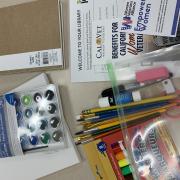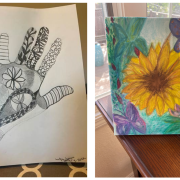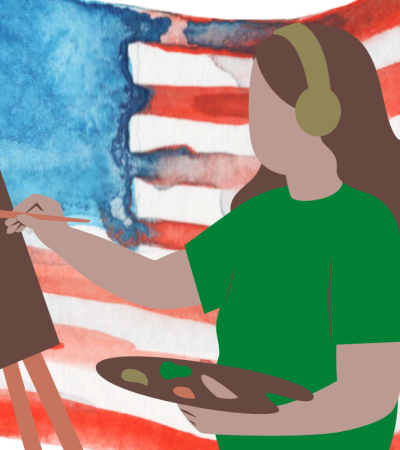Sacramento Public Library held a virtual art therapy program for female veterans in partnership with Women Veterans Alliance. This four-week program met once a week for an hour.
Advanced Planning
Our goals for this program were to provide three critical elements for female veterans: a safe environment in which to express themselves, knowledge of local resources, and connection with fellow veterans. We started planning about five months prior to the program and first focused on booking the instructor and developing a plan with our partner.
We provided art supply kits to the first 20 participants. We prepared the kits ahead of time so they could be sent out as people registered. Each kit came in a large plastic envelope and included:
- Mixed media journal
- Watercolor set
- Paintbrushes
- Permanent marker, pencil, eraser
- Scissors
- Tissue paper
- Tape, masking tape
- Glue stick
- Markers
Marketing
Two months before the program, we reached out to our contacts at CalVet, Veterans Connect at the Library, and the County Veteran Services Office with information about the program and a flyer to help spread the word. We also presented at a local veteran’s collaborative meeting a month before the program, posted information about the program to the veterans page on our website, and created an event on Facebook.
The most successful promotion came from our partnership with Women Veterans Alliance. They shared the event on their Facebook page, and we received registrations from participants all over the U.S.
Budgeting
There were two costs associated with the program: art supplies and the instructor fee. Art supplies totaled $550. We purchased art supplies to create 20 kits for participants. All of the items were purchased at either Dollar Tree or Michaels. The instructor fee was $400 payment for four hours of instruction.
To cut costs, you could share the list of supplies needed for the program, then offer to fill in the items that patrons don’t already have or just offer some of the main items, such as the journal and watercolor set.
Day-of-event Activity
One staff person ran the Zoom meeting and introduced the speakers, who were each joining from different locations.
The run of show is as follows:
- Library staff shared short introduction and information about Women Veterans Alliance (5 mins.)
- Women Veterans Alliance director shared services and programs at their organization (10 mins.)
- Library staff introduced the art instructor
- The art instructor opened with 5 mins. of breathing and mindfulness exercises, then led participants through art project (40 mins.)
- Library staff wrapped up (5 mins.)
Program Execution
Altogether, 22 people participated in the four-week program. Participants shared that they enjoyed the opportunity to be creative and explore different art materials and that they learned about Women Veterans Alliance at the program and intended to use one of their services.
We received the following comments in a post-program survey: “I really appreciate that this group was offered. It’s nice that veterans are being recognized as a group that would benefit from art" and “I appreciated that it was on Zoom. I could do art, but not have to talk to anyone. I’m pretty introverted and when you add in PTSD, anxiety and depression, taking an art class is way out of my reach. But this one let me just do some art while being part of the group though not having to get anxious about interacting.”
Given the positive feedback and response to this program, we will be offering another session in the future.
Advice
In our post-program survey, we received feedback from multiple participants asking to extend the length of each session to at least 90 minutes to allow more time to work on the art projects.
A hybrid option can also work well for this program; it would allow those who are uncomfortable around others to participate from the privacy of their home, while also allowing others to connect in person. Since it was virtual, it was difficult to see when the instructor showed something up close or when the participants showed off their projects.
Also, partnering with a local organization that served the program’s audience was so valuable. Their director was able to provide input as we developed the program, and their reach to female veterans nationwide led to new participants that we wouldn’t have been able to reach otherwise.
Supporting Materials
- Feedback (Coming Soon!)
- Programming Librarian Facebook Group




